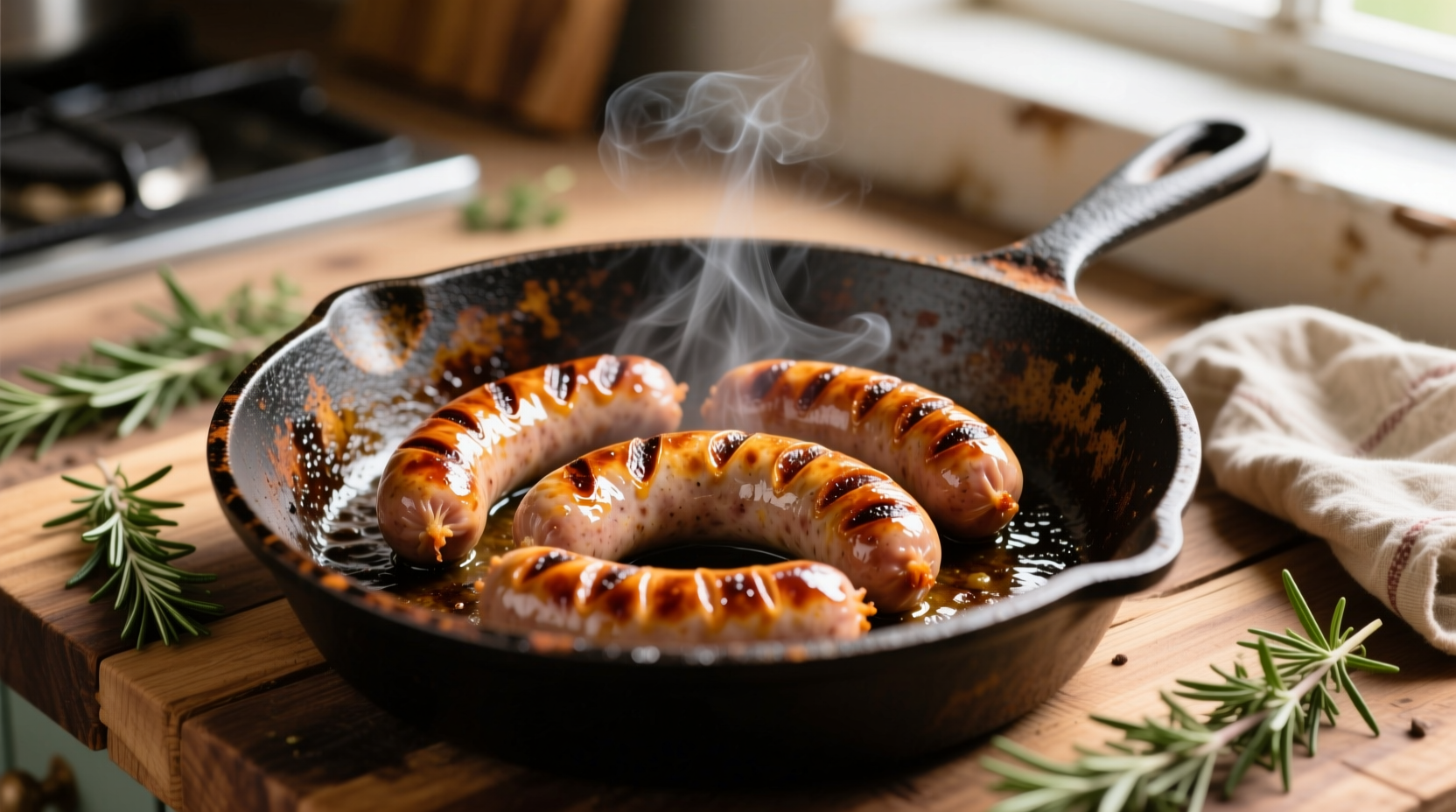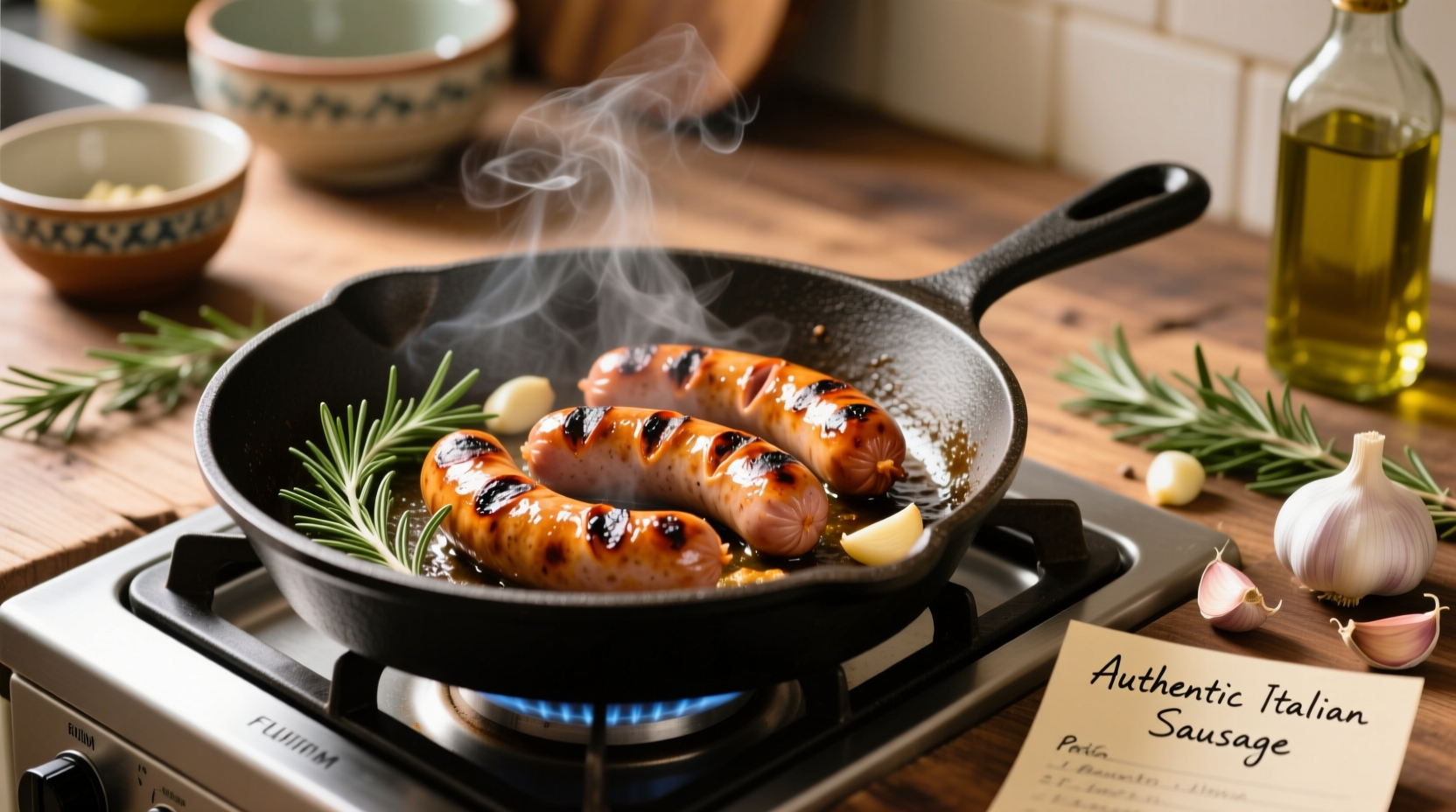Italian sausage should be cooked to an internal temperature of 160°F (71°C) using one of four reliable methods: pan-frying (12-15 minutes), grilling (15-20 minutes), baking (20-25 minutes at 375°F), or simmering (10-12 minutes). Always use a meat thermometer to verify doneness, as color alone isn't a reliable indicator.
Cooking Italian sausage perfectly requires understanding both technique and the unique characteristics of this flavorful meat. Unlike plain pork sausage, Italian sausage contains fennel, garlic, and other spices that influence both cooking behavior and flavor development. Whether you're preparing sweet or hot varieties, fresh or pre-cooked links, this guide provides professional techniques that guarantee juicy, flavorful results every time.
Understanding Italian Sausage Before You Start
Before heating your pan or grill, recognize what makes Italian sausage different from other sausages. Traditional Italian sausage comes in two primary varieties: sweet (mild) with fennel as the dominant flavor, and hot with added red pepper flakes. Both contain 20-30% fat content, which is crucial for flavor but requires careful cooking to prevent flare-ups and splitting.
According to the USDA Food Safety and Inspection Service, properly handled raw sausage maintains safety when kept below 40°F until cooking. Always inspect packaging for "fresh" versus "pre-cooked" labels, as this dramatically affects cooking time. Fresh sausage requires full cooking, while pre-cooked varieties only need heating through.
| Cooking Method | Prep Time | Cook Time | Internal Temp | Best For |
|---|---|---|---|---|
| Pan-Frying | 2 min | 12-15 min | 160°F | Weeknight meals, small batches |
| Grilling | 5 min | 15-20 min | 160°F | Outdoor cooking, summer meals |
| Baking | 3 min | 20-25 min | 160°F | Hands-off cooking, multiple links |
| Simmering | 2 min | 10-12 min | 160°F | Sauces, soups, casseroles |
Pan-Frying: The Most Accessible Method
Pan-frying delivers excellent browning and caramelization while maintaining control over the cooking process. Professional chefs prefer this method for weekday cooking because it works with standard kitchen equipment and provides visual feedback throughout.
Step-by-step pan-frying:
- Place links in a cold skillet (cast iron works best)
- Add 1/4 cup water to prevent initial burning
- Cover and cook over medium heat for 10 minutes
- Uncover, increase heat to medium-high
- Turn frequently until golden brown (3-5 minutes)
- Rest for 3 minutes before serving
The water-steam method prevents the casing from splitting while ensuring thorough cooking. As noted in the USDA Food Safety guidelines, this technique reduces the risk of undercooked centers while developing flavorful Maillard reactions on the exterior.

Grilling Italian Sausage Without Disaster
Grilling creates distinctive char marks and smoky flavor, but requires special attention due to Italian sausage's high fat content. The key is managing flare-ups while ensuring even cooking.
Grill setup and technique:
- Preheat grill to medium (350-375°F)
- Create two zones: direct heat and indirect heat
- Start over indirect heat for 8-10 minutes
- Move to direct heat for final browning (2-3 minutes per side)
- Rotate frequently using tongs, not forks
Avoid piercing the casing with forks, as this releases flavorful juices. If flare-ups occur, temporarily move sausages to the indirect zone. According to culinary research from the Culinary Institute of America, this two-zone approach prevents the exterior from burning before the interior reaches safe temperature.
Baking: The Hands-Off Approach
Baking produces evenly cooked sausage with minimal attention required, making it ideal for meal prep or entertaining. This method works particularly well for multiple links.
Perfect baked Italian sausage:
- Preheat oven to 375°F
- Arrange links on wire rack over baking sheet
- Cook for 20-25 minutes, turning halfway
- Check internal temperature reaches 160°F
- Broil 1-2 minutes for extra browning (optional)
The wire rack allows hot air circulation for even cooking and prevents steaming. For crispier results, lightly spray sausages with oil before baking. This method delivers consistent results regardless of sausage thickness, eliminating the common problem of uneven cooking that occurs with other techniques.
Simmering for Sauces and Soups
When incorporating Italian sausage into pasta sauces or soups, simmering first ensures thorough cooking while infusing the liquid with flavor.
Proper simmering technique:
- Place links in cold liquid (broth, wine, or water)
- Bring to gentle simmer (180-190°F)
- Cook covered for 10-12 minutes
- Remove, pat dry, then finish in pan for browning
This method, documented in traditional Italian cookbooks like La Cucina: The Regional Cooking of Italy, ensures the sausage cooks through without releasing excessive fat into your sauce. The gentle heat prevents casing rupture while allowing flavors to meld.
Critical Safety and Doneness Guidelines
Despite popular belief, color alone cannot verify doneness. The USDA Food Safety and Inspection Service emphasizes that pork products, including Italian sausage, must reach 160°F internally to eliminate potential pathogens.
Accurate temperature verification:
- Use an instant-read thermometer inserted sideways
- Test multiple links, not just one
- Check thickest part without touching bone (if present)
- Allow 3-minute rest time before serving
Visual indicators include firm texture (not soft or mushy), clear juices (not pink), and golden-brown exterior. However, these should only supplement thermometer readings, not replace them.
Troubleshooting Common Cooking Problems
Sausage splitting: Caused by rapid temperature changes or overfilling. Prevent by starting in cold pan and avoiding high initial heat.
Dry or tough results: Typically from overcooking. Remove from heat at 155°F, as carryover cooking will raise temperature 5 degrees during resting.
Uneven cooking: Occurs with irregularly shaped links. Rotate frequently and use indirect heat methods for thicker sections.
Excessive flare-ups: Manage by keeping a spray bottle of water nearby and temporarily moving sausages away from flames.
Serving Suggestions That Honor Tradition
Authentic Italian preparation serves cooked sausage with simple accompaniments that highlight its flavor. Traditional pairings include:
- Peppers and onions sautéed in the sausage drippings
- Fresh crusty bread for soaking up juices
- Sharp provolone or aged pecorino cheese
- Light arugula salad with lemon vinaigrette
For a complete meal, serve with pasta (like rigatoni) and a robust tomato sauce. The fat from the sausage emulsifies with the sauce, creating a rich, cohesive dish that exemplifies Italian cucina povera (peasant cooking) traditions.











 浙公网安备
33010002000092号
浙公网安备
33010002000092号 浙B2-20120091-4
浙B2-20120091-4